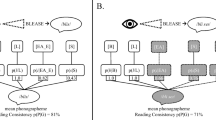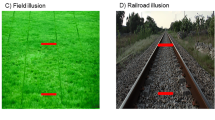Abstract
This study assessed whether arbitrary stimulus classes would emerge via elements of complex sample stimuli. College students learned matching to sample (AB-D/AC-E) where D and E forms were selected conditionally upon complex tone/color samples (AB and AC). Unreinforced tests were then given to assess emergent relations among the five sets of stimuli (e.g., A-B, D-B, B-C, B-E, and D-E). The test performances for 14 of 18 subjects were consistent with the experimentally defined stimulus classes. These 14 subjects were also given tests with new F forms as sample elements (Test AF-B). Subsequent testing for emergent relations (e.g., F-D and E-F) showed that the classes were expanded to six members each. the study demonstrated that the relations necessary for arbitrary class formation and expansion may be established without explicit training of each. The procedures permitted an analysis of six-member equivalence classes based on relations among elements of complex samples and their respective comparisons.
Similar content being viewed by others
References
COLAVITA, F. B. (1974). Human sensory dominance. Perception & Psychophysics, 16, 409–412.
DEVANY, J. M., HAYES, S. C., & NELSON, R. O. (1986). Equivalence class formation in language-able and language-disabled children. Journal of the Experimental Analysis of Behavior, 46, 243–257.
FIELDS, L., & VERHAVE, T. (1987). The structure of equivalence classes. Journal of the Experimental Analysis of Behavior, 48, 317–332.
FIELDS, L., VERHAVE, T., & FATH, S. (1984). Stimulus equivalence and transitive associations: A methodological analysis. Journal of the Experimental Analysis of Behavior, 42, 143–157.
LAZAR, R. M., DAVIS-LANG, D., & SANCHEZ, L. (1984). The formation of stimulus equivalences in children. Journal of the Experimental Analysis of Behavior, 41, 251–266.
LOVAAS, O. I., KOEGEL, R. L., & SCHREIBMAN, L. (1979). Stimulus overselectivity in autism: A review of research. Psychological Bulletin, 86, 1236–1254.
MACKINTOSH, N. J. (1974). The psychology of animal learning. New York: Academic Press
POSNER, M. I., NISSEN, M. J., & KLEIN, R. M. (1976). Visual dominance: An information-processing account of its origins and significance. Psychological Review, 83, 157–171.
RANDICH, A., KLEIN, R. M., & LOLORDO, V. M. (1978). Visual dominance in the pigeon. Journal of the Experimental Analysis of Behavior, 40, 129–137.
REYNOLDS, G. S. (1961). Attention in the pigeon. Journal of the Experimental Analysis of Behavior, 4, 203–208.
RUDOLPH, R. L., & VAN HOUTEN, R. (1977). Auditory stimulus control in pigeons: Jenkins and Harrison (1960) revisited. Journal of the Experimental Analysis of Behavior, 27, 327–330.
SAUNDERS, R. R., SAUNDERS, K. J., KIRBY, K. C., & SPRADLIN, J. E. (1988). The merger and development of equivalence classes by unreinforced conditional selection of comparison stimuli. Journal of the Experimental Analysis of Behavior, 50, 145–162.
SAUNDERS, R. R., WACHTER, J., & SPRADLIN, J. E. (1988). Establishing auditory stimulus control over an eight-member equivalence class via conditional discrimination procedures. Journal of the Experimental Analysis of Behavior, 49, 95–115.
SCHREIBMAN, L., KOEGEL, R. L., & CRAIG, M. S. (1977). Reducing stimulus overselectivity in autistic children. Journal of Abnormal Child Psychology, 5, 425–436.
SIDMAN, M., KIRK, B., & WILLSON-MORRIS, M. (1985). Six-member stimulus classes generated by conditional-discrimination procedures. Journal of the Experimental Analysis of Behavior, 43, 21–42.
SIDMAN, M., RAUZIN, R., LAZAR, R., CUNNINGHAM, S., TAILBY, W., & CARRIGAN, P. (1982). A search for symmetry in the conditional discriminations of rhesus monkeys, baboons, and children. Journal of the Experimental Analysis of Behavior, 37, 23–44.
SIDMAN, M., & TAILBY, W. (1982). Conditional discrimination vs. matching to sample: An expansion of the testing paradigm. Journal of the Experimental Analysis of Behavior, 37, 5–22.
SIDMAN, M., WILLSON-MORRIS, M., & KIRK, B. (1986). Matching-to-sample procedures and the development of equivalence relations: the role of naming. Analysis and Intervention in Developmental Disabilities, 6, 1–19.
SPRADLIN, J. E., COTTER, V. W., & BAXLEY, N. (1973). Establishing a conditional discrimination without direct training: A study of transfer with retarded adolescents. American Journal of Mental Deficiency, 77 556–566.
SPRADLIN, J. E., & SAUNDERS, R. R. (1986). The development of stimulus classes using match-to-sample procedures: Sample classification versus comparison classification. Analysis and Intervention in Developmental Disabilities, 6, 41–58.
STODDARD, L. T., & SIDMAN, M. (1971). The removal and restoration of stimulus control. Journal of the Experimental Analysis of Behavior, 16, 143–154.
STROMER, R. (1986). Control by exclusion in arbitrary matching-to-sample. Analysis and Intervention in Developmental Disabilities, 6, 59–72.
STROMER, R. (1989). Symmetry of control by exclusion in humans’ arbitrary matching to sample. Psychological Reports, 64, 915–922.
STROMER, R., & OSBORNE, J. G. (1982). Control of adolescents’ arbitrary matching-to-sample by positive and negative stimulus relations. Journal of the Experimental Analysis of Behavior, 37, 329–348.
WARREN, J. M. (1953). Additivity of cues in visual pattern discriminations by monkeys. Journal of Comparative and Physiological Psychology, 46, 484–486.
WETHERBY, B., KARLAN, G. R., & SPRADLIN, J. E. (1983). The development of derived stimulus relations through training in arbitrary-matching sequences. Journal of the Experimental Analysis of Behavior, 40, 69–78.
Author information
Authors and Affiliations
Additional information
Portions of this study were presented at the 1988 meeting of the Association for Behavior Analysis. the research was conducted at Northern Michigan University. Preparation of the manuscript occurred at the Shriver Center with financial support from the Department of Mental Retardation of the Commonwealth of Massachusetts (Contract No. 3403-8403-306) and from Nichd Grant Hd05515. We are grateful to Fay lennaco, Bill Dube, and Bill Mcllvane for their assistance in preparing the manuscript.
Rights and permissions
About this article
Cite this article
Stromer, R., Stromer, J.B. The Formation of Arbitrary Stimulus Classes in Matching to Complex Samples. Psychol Rec 40, 51–66 (1990). https://doi.org/10.1007/BF03399571
Published:
Issue Date:
DOI: https://doi.org/10.1007/BF03399571




